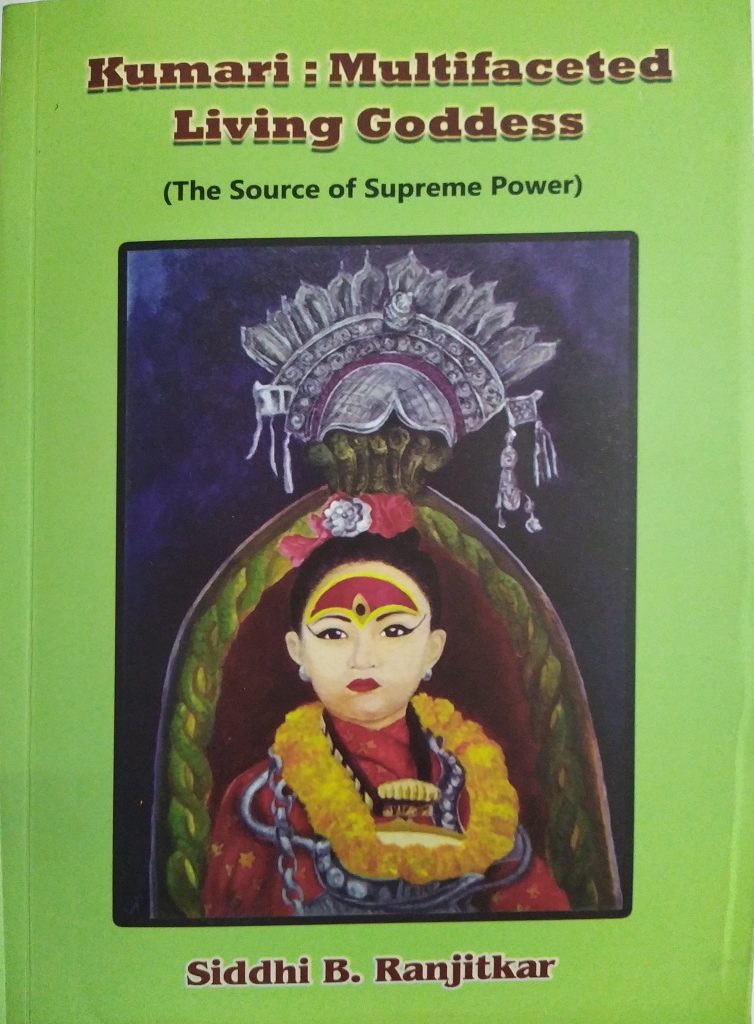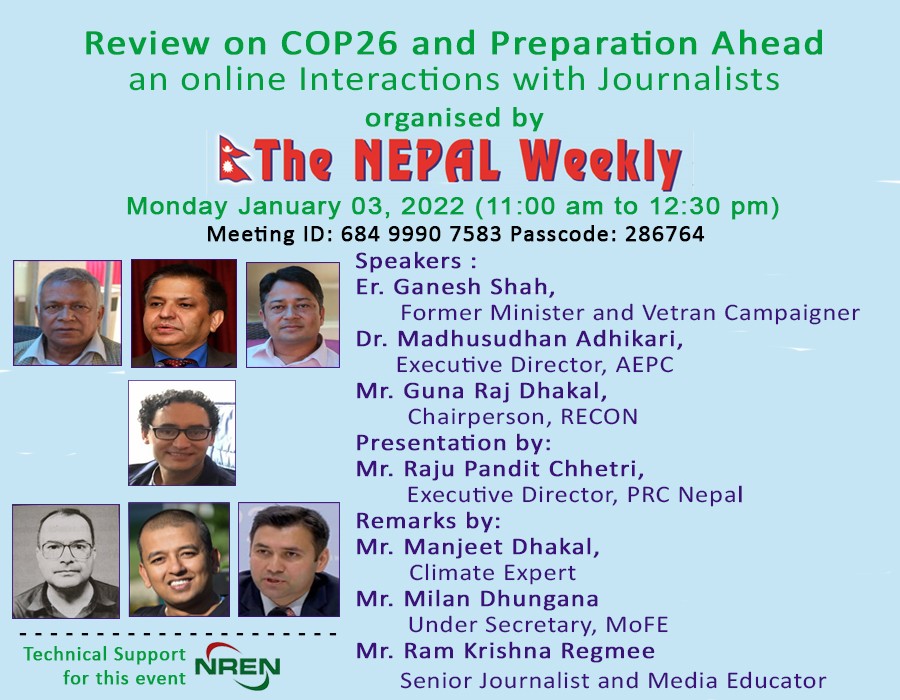Good book for reference purpose too for the researchers
 The Nepal Weekly
The Nepal Weekly  June 28, 2022
June 28, 2022
Reviewed by Prakash Prasad Upadhyay

While writing these lines, an image of the Kumari, The Living Goddess of Nepal, is appearing before my eyes as I had an opportunity to have audience with her (darshan of the deity) at various times during my visits to Kathmandu, nearly 3 decades ago, and get her blessings in the form of a tika (a sacred paste of curd, vermilion and rice offered to the deity which is placed on the forehead of the worshipper or devotees). As a visitor to KumariGhar, the earthly abode of The Living Goddess, I luckily got a chance to get her audience and tika on those occasions.
The recently released book-Kumari: Multifaceted Living Goddess-written by a scholar Siddhi B. Ranjitkar, gave me another opportunity to get the darshan (beholding) of the deity. The book which is in my hand gave me another opportunity to read about her in details and scratch few lines in the form of review of the book, which has more than 450 pages.
Why the book dedicated to the deity, is titled as Kumari; Multifaceted Living Goddess? This question arose in my mind when I got the book. But while going through the book, I found the answer. The writer Siddhi B. Ranjitkar writes “The Living Goddess is a multifaceted deity, as the goddess takes one of many forms and names whenever a situation demands. So, the Goddess Kumari is DurgaBhavani, TalejuBhavani, Candesvari, Mahalaxmi, Visnudevi, Vajrayogini and so on. The Goddess possesses supreme power and the sovereignty of any state.
He further writes”The Living Goddess Kumari is politically highly charged deity and any ruler needed the mandate of ruling over the state from the deity because the deity represents the Goddess of warriors DurgaBhavani. She is the deity of all Saivites, Vaishnavas, and Vajrayana Buddhists who worship her in different names to suit them. Culturally, a Virgin Goddess worshipped as a supreme deity that presides over major religious events, and socially the deity worshipped at the end of major social events.’ Highlighting the importance of the goddess the writer writes-the goddess is associated with almost all festivals and the social events the Nevah community celebrates in Kathmandu and elsewhere in the Nevah colony.’ As she is a Virgin Goddess, she is addressed with respect as ‘Kumari’ too and in her name a Jatra (Chariot Festival) was initiated by a Licchavi king Gunakamdeva.’ He set the tradition of seeking the mandate from her to run the administration as the then citizens did not accept anybody as a sovereign unless the monarch secured the mandate from The Living Goddess KumarI. Since then Kings and nobles needed the blessings of the Living Goddess Kumari to rule over the country.’
Malla kings, who replaced the Licchavi kings at the beginnings of second millennium, kept the tradition but one of the Malla kings added one more day to the celebration of the Jatra to receive the mandate from the deity to run the city administration and continued the Jatra every year. Thus, it became a three-day celebration and an annual feature. In the mid-eighteenth century, another Malla King JayprakashMalla, the last Malla king, made it a four-day festival and made a lavish four-wheeled three-roofed golden chariot for the deity and named it as the KumariJatra. Since then this festival is known as KumariJatra. Later, the celebration of this festival was extended to eight days when the Gorkha King Prithvinarayan Shah took the reign of the country from JayprakshMalla in a surprise attack on the day of IndraJatra and succeeded to receive blessings and tika from the deity to rule over the nation.
The tradition of taking the procession (Chariot Jatra) of the Living Goddess around the town must have been long before as in early years it was known as Yae-YaaJatra, which later metamorphosed into the KumariJatra, and finally IndraJatra. Since Nevahs are the indigenous folks of the Nepal valley, the 461 pages book, which contains Footnotes, which exclusively highlight various aspects of Nevah people, their culture and traditions and various religious rites, and References, Index. The writer clearly explains the impact of the Deity Kumari’s power in the Nevah community, which is explained in the chapter of Attributes of Kumari. There are temples of the Kumari at various districts of Kathmandu. In addition to that, she is at every house of the Nevah community. Each house of Nevah community worship her as a virgin girl (Kumari, the deity), who is the symbol of Devine Power, who killed the demon king Mahisasura. Hence she is worshipped as long as she does not attain the age of puberty. On the 10th day, the people conclude this special offering of virgin girls and celebrate VijayaDashami, (Day of Victory), which is an important part of the festival.
The chariot festival is famous as IndraJatra too, because of a mythological reference attached to this festival. It is said – Lord Indra, a heavenly God had visited this land to pluck the flower of Parijat as ordered by His mother for the sake of worship of her deity. It is regarded as a holy flower. As the story says, it was brought by Lord Krishna from the heaven to this land. As lord Indra had entered into the compound of the house without the permission of its owner and was plucking the flower, He was caught red handed, produced before the king and punished as per law of the country. In order to spread a message to the people that whosoever one may be, anyone who indulges in stealing cannot be spared. Thus, this festival was named as IndraJatra. Lakhe Dance (a mask dance performed by an imaginary demon deity to appease the Kumari) makes the festival colourful and it too has become a part of this festival. This demon deity too has a long history as some folks think that Lakhe is the caregiver of Taleju, i.e, DurgaBhavani.
The 461 pages book speaks about the pains writer took, as the book contains many facts of History (political, religious and social), religious places and temples of Kathmandu Valley and various folklores. It also stated that TalejuBhavan is an indigenous deity unlike the popular belief of TalejuBhavani was brought in. Likewise, the Malla kings were also locals. Thus, the book, though named as ‘Kumari; Multifaceted Living Goddess’, can be called the history of ancient Nepal, wherein the impact of modern days political developments has its reflections.
In short, it is an interesting book for all book lovers, especially for those foreign readers, who are interested to know in detail about The Living Goddess, method of her selection, Nevah community’s culture, traditions, their deities, religious rites and other related matter. It also removes many mis-conceptions in regard to the Kumari – Living Goddess of Nepal.
Kumari : Multifaceted Living Goddess (The Source of Supreme Power) is the 464 page book which is priced NRs. 1500 and US$ 25. This was published by writer Ranjitkar himself. The book may be purchased from the publisher writing an email at siddhiranjit@gmail.com or call Kumar at 9841302023.
(Prakash Prasad Upadhyaya is a Freelance Journalist and Writer)

